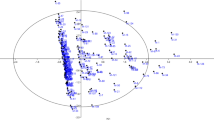Abstract
Almond production in Iran occupies an important place in worldwide production and is of considerable importance in terms of providing genetic resources. In this study, 90 almond genotypes were evaluated using 60 morphological and agronomic characters. Results reflected a significant diversity in the assayed almond germplasm. All traits showed large differences between the studied almonds especially the nut and kernel dimensions, weight, flowering and ripening dates, kernel yield and percentage of double kernels. Furthermore, most of the agronomic traits were correlated, although the correlation coefficients were higher than 0.50 only in some cases. Morphological traits were categorized by principal components analysis (PCA) into 17 components which explained 77 % of the total variation. An unweighted pair-group method of arithmetic average dendrogram and a scatter plot of PCA scores showed high variation between almond genotypes, indicating that the studied germplasm can be considered a good gene pool for breeding programs. Some genotypes could be good genitors for increasing kernel size or can be considered unique, promising types for breeding or commercial growing. Also, some were late-flowering, and so can be used in breeding for later flowering.


Similar content being viewed by others
References
Amarowicz R, Troszynska A, Shahidi F (2005) Antioxidant activity of almond seed extract and its fractions. J Food Lipids 12:344–358
Arulsekar S, Parfitt DE, Kester DE (1986) Comparison of isozyme variability in peach and almond cultivars. J Hered 77:272–274
Beppu K, Ikeda T, Kataoka I (2001) Effect of high temperature exposure time during flower bud formation on the occurrence of double pistils in `Satohnishiki’ sweet cherry. Sci Hortic 87:77–84
Colic S, Rakojac V, Zec G, Nikolic D, Aksic MF (2012) Morphological and biochemical evaluation of selected almond [Prunus dulcis (Mill.) D.A.Webb] genotypes in northern Serbia. Turk J Agric For 36:429–438
Dicenta F, Garcia JE (1992) Phenotypical correlations among some traits in almond. J Genet Breed 46:241–246
Ghahreman A, Attar F (1999) Biodiversity of plant species in Iran, vol 1. Publication of Tehran University, Tehran
Gulcan R (ed) (1985) Descriptor list for almond (Prunus amygdalus). International Board for Plant Genetic Resources, Rome
Hammer Ø, Harper DAT, Ryan PD (2001) PAST: paleontological statistics software package for education and data analysis. Palaeontol Electron 4(1):9. http://palaeoelectronica.org/2001_1/past/issue1_01.htm
Iezzoni AF, Pritts MP (1991) Applications of principal components analysis to horticultural research. HortSci 26:334–338
Kester DE, Gradziel TM, Grasselly C (1991) Almonds (Prunus). In: Moore JM, Ballington JR (eds) Genetic resources of temperate fruit and nut crops. The International Society for Horticultural Science, Wageningen, The Netherlands, pp 701–758
Khadivi-Khub A, Zamani Z, Fatahi MR (2012) Multivariate analysis of Prunus subgen. Cerasus germplasm in Iran using morphological variables. Genet Resour Crop Evol 59:909–926
Khadivi-Khub A, Jafari HR, Zamani Z (2013) Phenotypic and genotypic variation in Iranian sour and duke cherries. Trees 27:1455–1466
Lansari A, Iezzoni AF, Kester DE (1994) Morphological variation within collection of Moroccan almond clones and Mediterranean and North American cultivars. Euphytica 78:27–41
Ledbetter CA, Shonnard CB (1992) Evaluation of selected almond (Prunus dulcis (Miller) D.A. Webb) germplasm for several shell and kernel characteristics. Fruit Var J 46:79–82
Martinez-Calvo J, Gisbert AD, Alamar MC, Hernandorena R, Romero C, Llacer G, Badenes ML (2008) Study of a germplasm collection of loquat (Eriobotrya japonica Lindl.) by multivariate analysis. Genet Resour Crop Evol 55:695–703
Nikolic D, Rakonjac V, Milatovic D, Fotiric M (2010) Multivariate analysis of vineyard peach [Prunus persica (L.) Batsch.] germplasm collection. Euphytica 171:227–234
Nikoumanesha K, Ebadi A, Zeinalabedini M, Gogorcena Y (2011) Morphological and molecular variability in some Iranian almond genotypes and related Prunus species and their potentials for rootstock breeding. Sci Hortic 129:108–118
Prats-Moya S, Grane-Teruel N, Berenguer-Navarro V, Martin-Carratala ML (1997) Inductively coupled plasma application for the classification of 19 almond cultivars using inorganic element composition. J Agr Food Chem 45:2093–2097
Rickter AA (1972) L’amandier. Academie Sciences Agricoles, Jardin Botanique de Nikits, Yalta
Rohlf FJ (2000) NTSYS-pc Numerical Taxonomy and Multivariate Analysis System. Version 2. 1. Exeter Software, Setauket, NY
Ruiz D, Egea J (2008) Phenotypic diversity and relationships of fruit quality traits in apricot (Prunus armeniaca L.) germplasm. Euphytica 163:143–158
Sanchez-Perez R, Ortega E, Duval H, Martınez-Gomez P, Dicenta F (2007) Inheritance and relationships of important agronomic traits in almond. Euphytica 93:39–44
SAS® Procedures (1990) Version 6, 3rd edn. SAS Institute, Cary, NC
Socias i Company R (1992) Breeding self-fertile almonds. Plant Breed Rev 8:313–338
Sorkheh K, Shiran B, Rouhi V, Asadi E, Jahanbazi H, Moradi H, Gradziel TM, Martinez-Gómez P (2009) Phenotypic diversity within native Iranian almond (Prunus spp.) species and their breeding potential. Genet Resour Crop Evol 56:947–961
Sorkheh K, Shiran B, Khodambashi M, Moradi H, Gradziel TM, Martinez-Gomez P (2010) Correlations between quantitative tree and fruit almond traits and their implications for breeding. Sci Hortic 125:323–331
Talhouk SN, Lubani RT, Baalbaki R, Zurayk R, Al Khatib A, Parmaksizian L, Jaradat AA (2000) Phenotypic diversity and morphological characterization of Amygdalus species in Lebanon. Genet Resour Crop Evol 47:93–104
Watkins R (1976) Cherry plum, peach, apricot, and almond. In: Simmonds NW (ed) Evolution of crop plants. Longman, London, pp 342–347
Zeinalabedini M, Sohrabi S, Nikoumanesh K, Imani A, Mardi M (2012) Phenotypic and molecular variability and genetic structure of Iranian almond cultivars. Plant Syst Evol 298:1917–1929
Author information
Authors and Affiliations
Corresponding author
Electronic supplementary material
Below is the link to the electronic supplementary material.
Rights and permissions
About this article
Cite this article
Khadivi-Khub, A., Etemadi-Khah, A. Phenotypic diversity and relationships between morphological traits in selected almond (Prunus amygdalus) germplasm. Agroforest Syst 89, 205–216 (2015). https://doi.org/10.1007/s10457-014-9754-x
Received:
Accepted:
Published:
Issue Date:
DOI: https://doi.org/10.1007/s10457-014-9754-x




